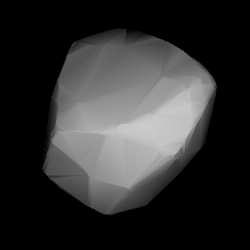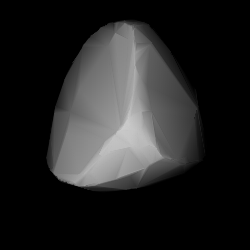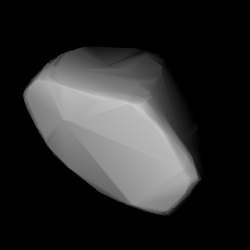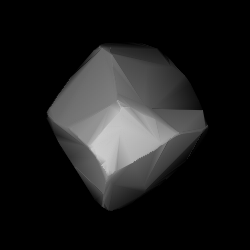Pawlowia, provisional designation 1923 OX, is a background asteroid from the central regions of the asteroid belt, approximately 20 kilometers in diameter. It was discovered on 5 October 1923, by Soviet astronomer Vladimir Albitsky at the Simeiz Observatory on the Crimean peninsula. The asteroid was named after Russian physiologist and Nobelist Ivan Pavlov.

1039 Sonneberga, provisional designation 1924 TL, is a dark background asteroid, approximately 34 kilometers in diameter, located in the central region of the asteroid belt. It was discovered on 24 November 1924, by German astronomer Max Wolf at Heidelberg Observatory in southwest Germany. The asteroid was named for the German city of Sonneberg, where the Sonneberg Observatory is located.

1030 Vitja, provisional designation 1924 RQ, is a dark background asteroid from the outer regions of the asteroid belt, approximately 60 kilometers in diameter. It was discovered on 25 May 1924, by Soviet–Russian astronomer Vladimir Albitsky at the Simeiz Observatory on the Crimean peninsula. The asteroid was named in honor of Viktor Zaslavskij (1925–1944), a relative of the discoverer.
1041 Asta, provisional designation 1925 FA, is a carbonaceous background asteroid from the outer regions of the asteroid belt, approximately 57 kilometers in diameter. It was discovered on 22 March 1925, by German astronomer Karl Reinmuth at the Heidelberg Observatory in southwest Germany. The asteroid was likely named after Danish actress Asta Nielsen.
1043 Beate, provisional designation 1925 HB, is a stony asteroid from the outer region of the asteroid belt, approximately 32 kilometers in diameter. It was discovered by German astronomer Karl Reinmuth at the Heidelberg-Königstuhl State Observatory on 22 April 1925. Any reference of its name to a person is unknown.
1059 Mussorgskia, provisional designation 1925 OA, is a background asteroid from the central regions of the asteroid belt, approximately 25 kilometers in diameter. It was discovered on 19 July 1925, by Soviet astronomer Vladimir Albitsky at the Simeiz Observatory on the Crimean peninsula. The asteroid was named for Russian composer Modest Mussorgsky. The X- or C-type asteroid has a rotation period of 5.636 hours.
1062 Ljuba, provisional designation 1925 TD, is a carbonaceous background asteroid from the outer regions of the asteroid belt, approximately 58 kilometers in diameter. The asteroid was discovered on 11 October 1925, by Soviet–Russian astronomer Sergey Belyavsky at the Simeiz Observatory on the Crimean peninsula. It was named after female paratrooper Ljuba Berlin, who died at an early age. The C-type asteroid has a longer-than average rotation period of 33.8 hours.
1092 Lilium, provisional designation 1924 PN, is a dark, carbonaceous background asteroid from the outer regions of the asteroid belt, approximately 44 kilometers in diameter. It was discovered on 12 January 1924, by German astronomer Karl Reinmuth at the Heidelberg Observatory in southwest Germany. The asteroid was named after the flower Lilium.

1118 Hanskya is a large background asteroid, approximately 77 kilometers in diameter, located in the outer regions of the asteroid belt. Discovered by Sergey Belyavsky and Nikolaj Ivanov in 1927, it was named after Russian astronomer Aleksey Hansky. The presumed dark C-type asteroid has a rotation period of 15.6 hours.
1567 Alikoski, provisional designation 1941 HN, is a rare-type carbonaceous asteroid from the outer region of the asteroid belt, approximately 67 kilometers in diameter. It was discovered on 22 April 1941, by Finnish astronomer Yrjö Väisälä at Turku Observatory in Southwest Finland. It was later named after Finnish astronomer Heikki Alikoski.

1457 Ankara, provisional designation 1937 PA, is a stony asteroid from the central region of the asteroid belt, approximately 18 kilometers in diameter. It was discovered on 3 August 1937, by German astronomer Karl Reinmuth at Heidelberg Observatory in southwest Germany, and later named for the Turkish capital city of Ankara.
1354 Botha, provisional designation 1935 GK, is an exceptionally dark background asteroid from the outer regions of the asteroid belt, approximately 46 kilometers in diameter. It was discovered on 3 April 1935, by South-African astronomer Cyril Jackson at the Union Observatory in Johannesburg. The asteroid was named after South African prime minister Louis Botha.

1328 Devota, provisional designation 1925 UA, is a dark background asteroid from the outermost regions of the asteroid belt, approximately 56 kilometers in diameter. It was discovered on 21 October 1925, by Russian–French astronomer Benjamin Jekhowsky at the Algiers Observatory in North Africa. The asteroid was named after Argentine astronomer Fortunato Devoto.
1524 Joensuu, provisional designation 1939 SB, is a carbonaceous asteroid from the outer region of the asteroid belt, approximately 42 kilometers in diameter. It was discovered on 18 September 1939, by Finnish astronomer Yrjö Väisälä at Turku Observatory in Southwest Finland, and named for the town of Joensuu.
1284 Latvia, provisional designation 1933 OP, is a rare-type asteroid from the middle region of the asteroid belt, approximately 37 kilometers in diameter. It was discovered on 27 July 1933, by German astronomer Karl Reinmuth at Heidelberg Observatory in southern Germany, and named after the Republic of Latvia.
1303 Luthera, provisional designation 1928 FP, is a dark asteroid and the parent body of the Luthera family, located in the outermost regions of the asteroid belt. It measures approximately 90 kilometers in diameter. The asteroid was discovered on 16 March 1928, by astronomer Friedrich Schwassmann at the Bergedorf Observatory in Hamburg, Germany, and later named after German astronomer Robert Luther.

1197 Rhodesia, provisional designation 1931 LD, is a dark background asteroid from the outer regions of the asteroid belt, approximately 48 kilometers in diameter. It was discovered on 9 June 1931, by South African astronomer Cyril Jackson at the Union Observatory in Johannesburg. The likely C-type asteroid has a rotation period of 16.1 hours. It was named for Rhodesia, a former British colony and unrecognised state, which is now Zimbabwe.
1760 Sandra, provisional designation 1950 GB, is a carbonaceous asteroid from the outer regions of the asteroid belt, approximately 35 kilometers in diameter. It was discovered on 10 April 1950, by South African astronomer Ernest Johnson at Union Observatory in Johannesburg, and named after his granddaughter Sandra.
1330 Spiridonia, provisional designation 1925 DB, is a dark background asteroid of primitive composition, located in the outer regions of the asteroid belt, approximately 65 kilometers in diameter. It was discovered on 17 February 1925, by Soviet astronomer Vladimir Albitsky at the Simeiz Observatory on the Crimean peninsula. The asteroid was named after the discoverer's brother-in-law, Spiridon Zaslavskij.
1302 Werra, provisional designation 1924 SV, is a Themistian asteroid from the outer regions of the asteroid belt, approximately 30 kilometers in diameter. It was discovered on 28 September 1924, by German astronomer Karl Reinmuth at the Heidelberg-Königstuhl State Observatory. The asteroid was named for the river Werra in central Germany.






